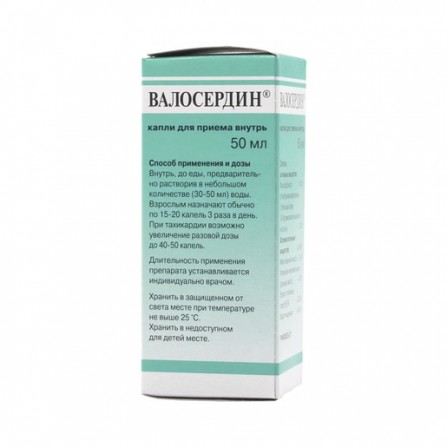Valoserdin drops for oral administration 50 ml
Condition: New product
992 Items
Rating:
Be the first to write a review!

More info
Active ingredients
Origanum common herb oil + Peppermint leaves oil + Phenobarbital + Ethyl bromovalerianate
Release form
Drops
Composition
Active ingredient: Phenobarbital - 2.0 g, Ethyl α-bromoisovaleric acid ester (ethyl bromisovalerianate) - 2.0 g, Peppermint oil - 0.14 g, Spanish hop oil (oregano oil) - 0.02 g, Auxiliary substances: Ethanol 96% - 469.75 mg, Purified Water - 411.97 mg Concentration of the active substance (g): 4.16 g
Pharmacological effect
Combined drug. Α-Bromoisovaleric acid ethyl ester is a sedative, light hypnotic and antispasmodic. Phenobarbital has a vasodilating and sedative effect, sleeping pills (in appropriate doses). Mint oil has a reflex vasodilator and spasmolytic activity.
Pharmacokinetics
Data on the pharmacokinetics of the drug is not provided.
Indications
Valoserdine is prescribed as a sedative and vasodilator for functional disorders of the cardiovascular system, for neurosis-like states accompanied by increased irritability, impaired sleep, tachycardia, a state of agitation with pronounced vegetative manifestations.
Contraindications
Hypersensitivity to the drug; severe impaired renal and / or liver function, pregnancy, lactation.
Precautionary measures
Do not exceed recommended doses.
Use during pregnancy and lactation
Contraindications: pregnancy; lactation period.
Dosage and administration
Valoserdin is accepted inside, to food, with a small amount of liquid. The dosage is set individually. Adults are usually prescribed 15-20 drops 3 times daily before meals. With tachycardia, it is possible to increase a single dose up to 40-50 drops. Children are prescribed at the rate of 1 drop per year of life of the child and depending on the clinical picture of the disease. The duration of the drug is determined individually by a doctor.
Side effects
Valoserdine is generally well tolerated even with prolonged use. In some cases, drowsiness and slight dizziness may occur during the daytime.With prolonged use of large doses may develop chronic bromine poisoning, manifestations of which are: depressive mood, apathy, rhinitis, conjunctivitis, hemorrhagic diathesis, impaired coordination of movements. If any adverse effects (unusual) effects that are not reflected in the instructions, should be reported to the attending physician.
Overdose
Symptoms: with mild and moderate intoxication - drowsiness, dizziness, psychomotor disturbances; in severe cases - lowering blood pressure, respiratory failure, tachycardia, collapse, decreased peripheral reflexes, coma. Treatment: gastric lavage, taking activated charcoal, symptomatic therapy.
Interaction with other drugs
With simultaneous use with sedatives - enhancing the effect. It can increase the toxicity of methotrexate. Simultaneous use with neuroleptics and anxiolytics increases, and with CNS stimulants - reduces the effect of each of the components of the drug. and sulfonamides, antifungal effect of griseofulvin (reduces absorption), the effectiveness of indirect anticoagulants, GCS, doxycycline, e trogenov and other drugs metabolized in the liver by the oxidation pathway (accelerates their destruction).
special instructions
Influence on the ability to drive motor vehicles and control mechanisms. During the period of treatment, it is necessary to refrain from engaging in potentially hazardous activities that require increased concentration of attention and quickness of psychomotor reactions.




